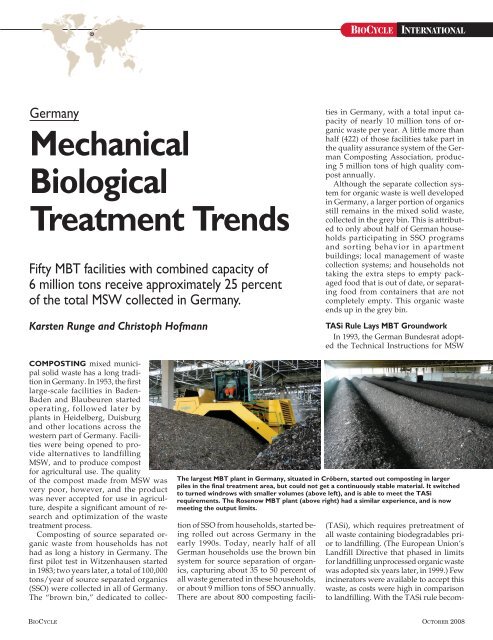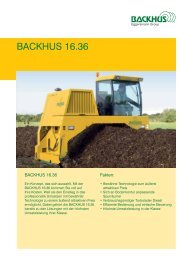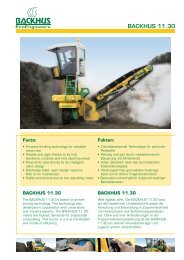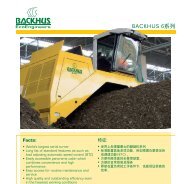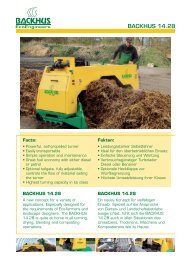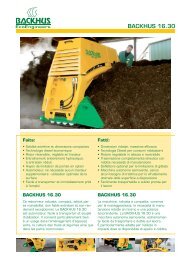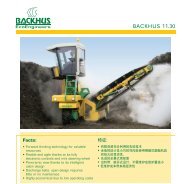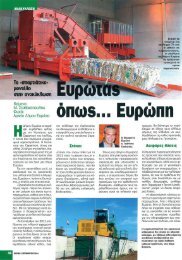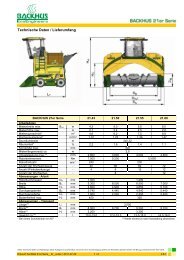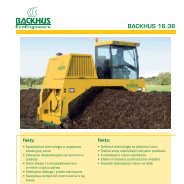Mechanical Biological Treatment Trends - Backhus
Mechanical Biological Treatment Trends - Backhus
Mechanical Biological Treatment Trends - Backhus
Create successful ePaper yourself
Turn your PDF publications into a flip-book with our unique Google optimized e-Paper software.
Germany<br />
<strong>Mechanical</strong><br />
<strong>Biological</strong><br />
<strong>Treatment</strong> <strong>Trends</strong><br />
Fifty MBT facilities with combined capacity of<br />
6 million tons receive approximately 25 percent<br />
of the total MSW collected in Germany.<br />
Karsten Runge and Christoph Hofmann<br />
COMPOSTING mixed municipal<br />
solid waste has a long tradition<br />
in Germany. In 1953, the first<br />
large-scale facilities in Baden-<br />
Baden and Blaubeuren started<br />
operating, followed later by<br />
plants in Heidelberg, Duisburg<br />
and other locations across the<br />
western part of Germany. Facilities<br />
were being opened to provide<br />
alternatives to landfilling<br />
MSW, and to produce compost<br />
for agricultural use. The quality<br />
of the compost made from MSW was<br />
very poor, however, and the product<br />
was never accepted for use in agriculture,<br />
despite a significant amount of research<br />
and optimization of the waste<br />
treatment process.<br />
Composting of source separated organic<br />
waste from households has not<br />
had as long a history in Germany. The<br />
first pilot test in Witzenhausen started<br />
in 1983; two years later, a total of 100,000<br />
tons/year of source separated organics<br />
(SSO) were collected in all of Germany.<br />
The “brown bin,” dedicated to collec-<br />
tion of SSO from households, started being<br />
rolled out across Germany in the<br />
early 1990s. Today, nearly half of all<br />
German households use the brown bin<br />
system for source separation of organics,<br />
capturing about 35 to 50 percent of<br />
all waste generated in these households,<br />
or about 9 million tons of SSO annually.<br />
There are about 800 composting facili-<br />
BIOCYCLE INTERNATIONAL<br />
ties in Germany, with a total input capacity<br />
of nearly 10 million tons of organic<br />
waste per year. A little more than<br />
half (422) of those facilities take part in<br />
the quality assurance system of the German<br />
Composting Association, producing<br />
5 million tons of high quality compost<br />
annually.<br />
Although the separate collection system<br />
for organic waste is well developed<br />
in Germany, a larger portion of organics<br />
still remains in the mixed solid waste,<br />
collected in the grey bin. This is attributed<br />
to only about half of German households<br />
participating in SSO programs<br />
and sorting behavior in apartment<br />
buildings; local management of waste<br />
collection systems; and households not<br />
taking the extra steps to empty packaged<br />
food that is out of date, or separating<br />
food from containers that are not<br />
completely empty. This organic waste<br />
ends up in the grey bin.<br />
TASi Rule Lays MBT Groundwork<br />
In 1993, the German Bundesrat adopted<br />
the Technical Instructions for MSW<br />
The largest MBT plant in Germany, situated in Cröbern, started out composting in larger<br />
piles in the final treatment area, but could not get a continuously stable material. It switched<br />
to turned windrows with smaller volumes (above left), and is able to meet the TASi<br />
requirements. The Rosenow MBT plant (above right) had a similar experience, and is now<br />
meeting the output limits.<br />
(TASi), which requires pretreatment of<br />
all waste containing biodegradables prior<br />
to landfilling. (The European Union’s<br />
Landfill Directive that phased in limits<br />
for landfilling unprocessed organic waste<br />
was adopted six years later, in 1999.) Few<br />
incinerators were available to accept this<br />
waste, as costs were high in comparison<br />
to landfilling. With the TASi rule becom-<br />
BIOCYCLE OCTOBER 2008
BIOCYCLE INTERNATIONAL<br />
ing effective in 2005 — prohibiting landfilling<br />
of mixed waste collected in the<br />
grey bin without pretreatment —most<br />
waste management companies started<br />
looking for alternatives.<br />
When TASi was adopted in 1993, mechanical<br />
biological treatment (MBT) was<br />
not recognized as meeting its requirements.<br />
But two new federal regulations<br />
later, MBT became an accepted alternative<br />
to incineration in 2001. An MBT system<br />
combines a sorting facility (like a<br />
materials recovery facility) with a form<br />
of biological treatment such as composting<br />
or anaerobic digestion to degrade the<br />
organic fraction. Between 2001 and 2005,<br />
a large number of MBT facilities and incineration<br />
plants started operating, just<br />
in time to meet the TASi deadline in June<br />
2005. Today 50 MBT facilities with combined<br />
capacity of 6 million tons receive<br />
approximately 25 percent of the total<br />
MSW collected in Germany. The MBT facilities<br />
feature different biological technologies,<br />
e.g., two-step aerobic treatment<br />
or a combination of anaerobic<br />
treatment followed by aerobic treatment.<br />
Reprinted From:<br />
October, 2008<br />
ADVANCING COMPOSTING, ORGANICS RECYCLING<br />
AND RENEWABLE ENERGY<br />
419 State Avenue, Emmaus, PA 18049-3097<br />
610-967-4135 • www.biocycle.net<br />
The TASi limits have to be met before<br />
the end product can be put into landfill.<br />
Typically, the end product of an MBT facility<br />
is not called compost, even if a<br />
composting process and composting<br />
technologies are used at the MBT facilities.<br />
The output product is ultimately<br />
landfilled.<br />
The MBT plants faced a lot of technical<br />
problems right from the start, with low<br />
throughput capacity caused by machine<br />
overload or breakdown and higher operational<br />
costs than expected due to high<br />
demand for maintenance and service.<br />
There also were challenges getting rid of<br />
the high caloric fraction produced during<br />
mechanical separation. Many problems<br />
were solved, and nearly all of the facilities<br />
are running at their expected<br />
capacities. One weak point at some MBT<br />
facilities is the final biological treatment<br />
process, which is often designed like a<br />
composting process.<br />
“We started our facility with a system<br />
of big heaps in the final treatment area,”<br />
explains Roland Greif, operations manager<br />
of the largest MBT plant in Ger-<br />
many, situated in Cröbern near Leipzig.<br />
“Fighting with the brand new machinery<br />
we learned a lot about the biological<br />
process but still could not get a constant<br />
and stable material in our output. We<br />
realized that even over a short period,<br />
the composition of the waste could<br />
change completely.”<br />
Facility operators decided to put the<br />
processed material into windrows with<br />
smaller volumes that can be treated separately.<br />
The plant purchased a BACK-<br />
HUS 6.68 turner. “Changing from heap to<br />
windrow, we can reach our targets<br />
faster,” adds Greif. “We can operate the<br />
turner according to the requirements of<br />
each single windrow.”<br />
Christoph Hofmann, operations manager<br />
of the biological treatment process<br />
at the Rosenow MBT plant in Mecklenburg,<br />
Germany, had a similar experience.<br />
“It is hard to continuously meet the<br />
TASi limits for oxygen consumption (5<br />
mg O2 /g DS), especially for dissolved<br />
organic carbon in eluate (DOCEluat =<br />
300 mg/l),” he says. “We have a total of<br />
nine weeks of biological treatment to<br />
achieve these limits. Our first treatment<br />
step is tunnel composting with fully automatic<br />
filling and emptying as well as<br />
under floor aeration, followed by our<br />
second treatment step — five to six<br />
weeks of composting in heaps.”<br />
During those last five weeks, the facility<br />
was seeing an increase of the DOC.<br />
“We presumed the reason for the increase<br />
is an adaptation of mostly fungi<br />
cultures that are capable of metabolizing<br />
long-chain organic molecules to soluble<br />
ones, while the further metabolism to<br />
produce CO 2 and water runs more slowly,”<br />
explains Hofmann. “In contrast to<br />
the intensive composting process with<br />
active aeration, the post composting process<br />
resulted in instability of the end<br />
product. We were running out of processing<br />
capacity because we were not<br />
reaching the limits in time. We also were<br />
experiencing high wear costs and constant<br />
downtime of our two turning machines.”<br />
The plant decided to switch<br />
from heaps to windrows. Since switching<br />
to windrows, the MBT plant has been<br />
able to meet its output limits. �<br />
Karsten Runge is Product Manager,<br />
Plant Engineering for BACKHUS Eco-<br />
Engineers GmbH and can be reached at<br />
karsten.runge@backhus.de. Christoph<br />
Hofmann is with ABG GmbH and can be<br />
reached at christoph.hofmann@ovvd.de.<br />
BIOCYCLE OCTOBER 2008


